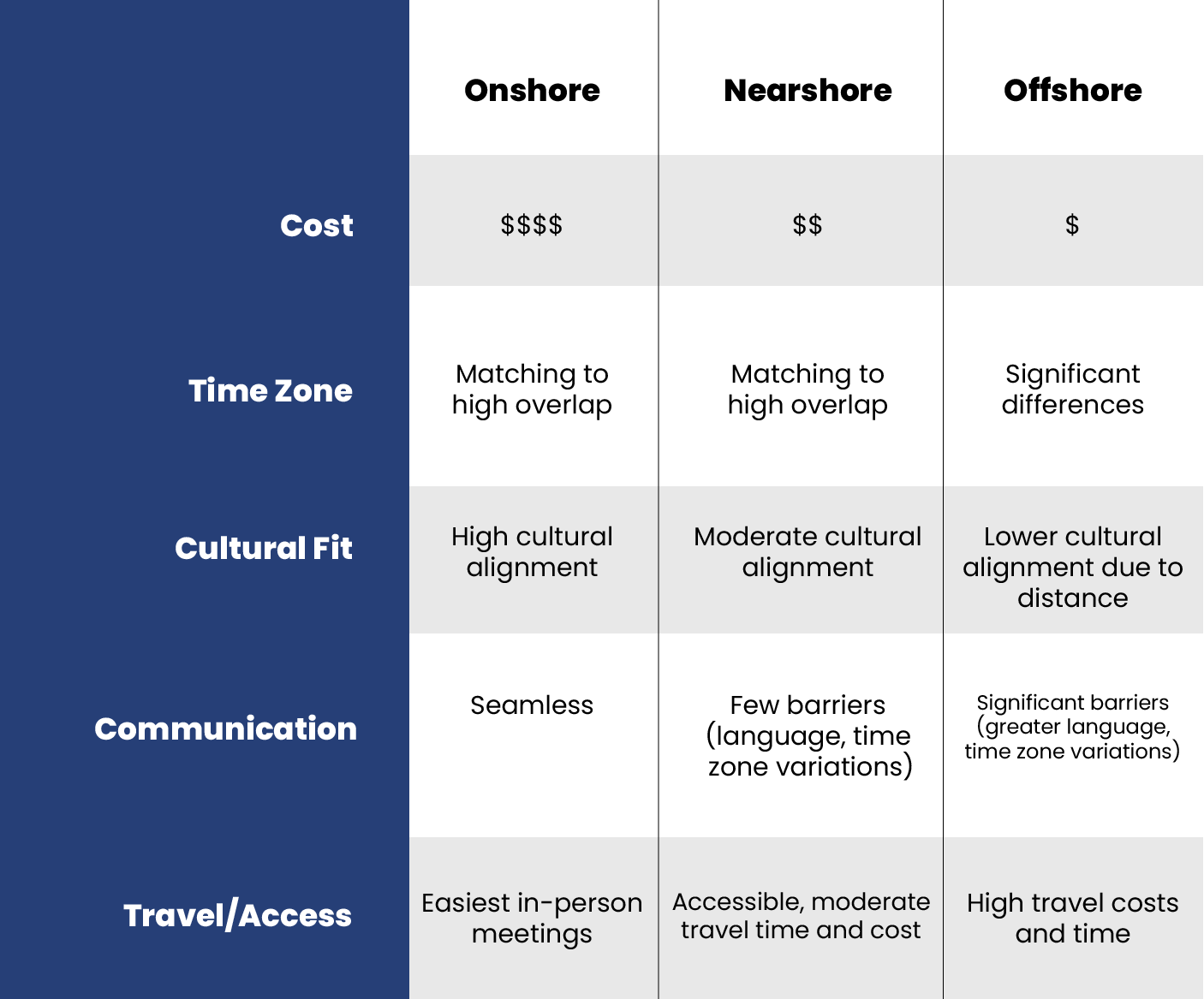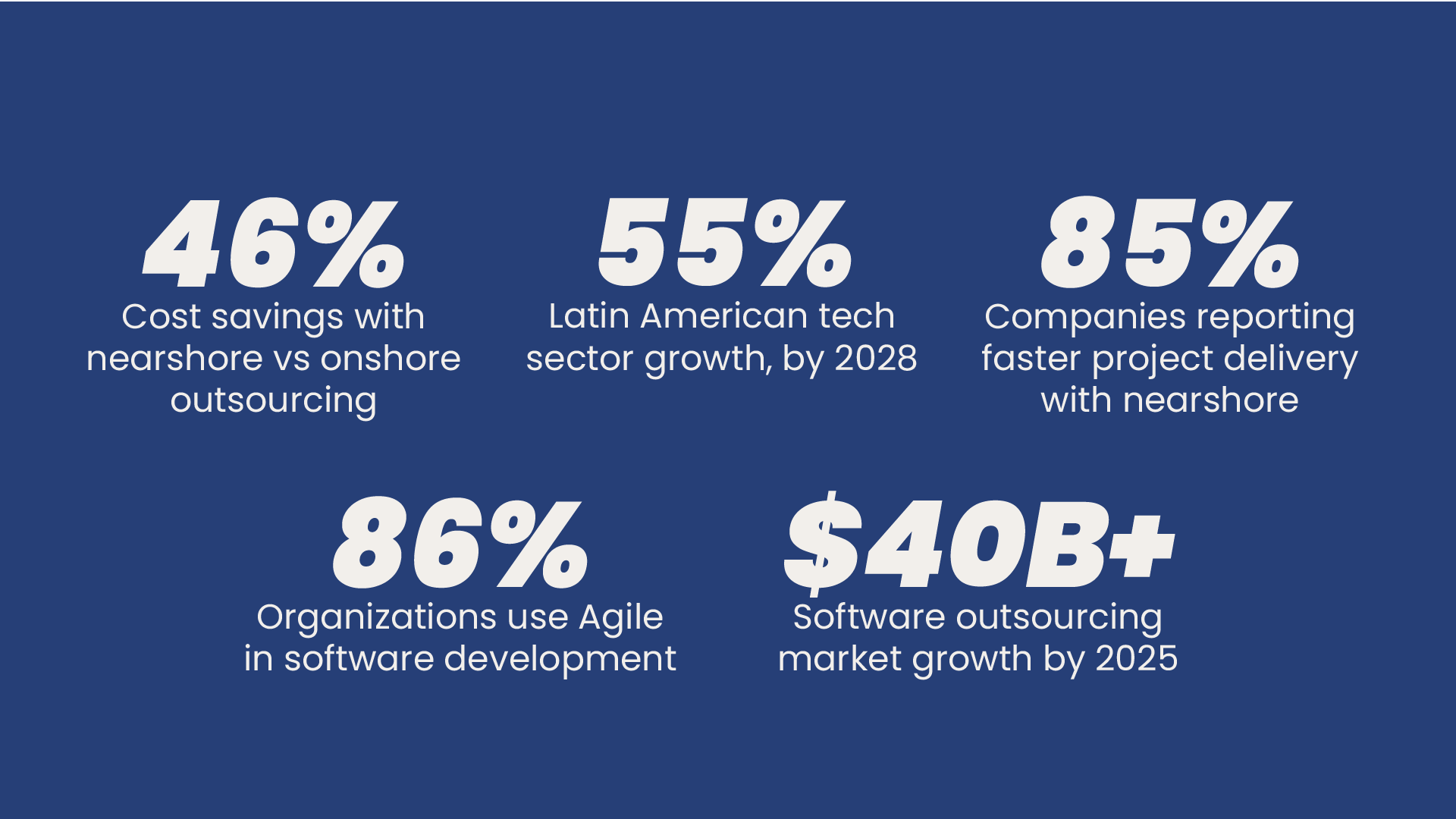Did you know that two-thirds of US businesses outsource at least one department? Some 37% of all IT tasks are outsourced, with the top jobs being programming and data entry.
You probably do, because this isn’t new: even back in 2009, America’s largest corporations employed 21.1 million Americans and 10.3 million workers outside the country, according to Forbes.
But what is new is how much of this is software development outsourcing (over half the global market value), and much of that is cloud-based.
At PTP, we have decades of expertise in the outsourcing market and have long been enthusiastic about the cost savings, talent pool, and follow-the-sun coverage offshore outsourcing can provide.
But lately, there’s another trend we’re seeing rise in popularity: nearshore software development.
And one of the driving reasons may surprise you. (Here’s a hint: it begins with the letter “A.”)
In this edition of The PTP Report, we dive into these trends—the surge in outsourced software development, the rise in one methodology for companies that do outsource, and the unique benefits nearshore outsourcing can provide.
Outsourcing and Software Development
These days, every company is also a tech company. This helps explain why, according to Precedence Research, the total IT outsourcing market is expected to reach $1.06 TRILLION by 2030.
This outsourcing usually involves countries very far from the US, like India, China, or the Philippines. It brings its own challenges (language, cultural fit, training, collaboration) and benefits (follow-the-sun coverage, diverse perspectives, size of the talent pool).
It is also typically the most cost-effective software development possible.
Having coverage at all hours can be fantastic for the right position, especially with the current global increase in cybercrime.
But there’s one serious drawback to traditional outsourcing that isn’t on that list, and that’s the fit with Agile.
The Agile software development methodology is not new but was created more than two decades back in response to more traditionally linear approaches like Waterfall. Agile is all about iteration—getting products built and delivered, in close contact with teammates and the customer both.
[For a great piece on Agile overall and the emergence of PODs, check out the article by our CEO, Nick Shah.]
But Agile was designed with onsite teams in mind, focused on gathering in a physical space, and typically on a daily basis (stand-ups). The goal is to keep everyone in sync and communication flowing.
And while there are numerous ways to go about Agile, this communication and real-time collaboration remain central, which is something that’s always made traditional outsourcing a tough match. When some of your team is halfway around the world (or increasingly, the whole team is scattered across it), ensuring the needed meetings happen and that there’s close contact gets increasingly idealistic or even impossible.
When this pairing does work, it requires overlapping work schedules, and even then, you frequently lose entire days of work when a quick response is needed or there’s a change or catch. This is something else common in Agile, which is also built to respond quickly to change. That’s ideal for an increasingly fast-paced world but harder to pair with offshore teams.
Numerous workaround versions of Agile have been created to attempt to manage this situation, but there’s no silver bullet.
Enter nearshore. By taking advantage of countries that are far closer to home (like Mexico, Brazil, and Argentina for the US), companies can still expand their available talent pool and save money but without grinding their development process to a halt at the same time.

Nearshore: The Middle Course
At PTP, we’re finding more and more partners seeking the advantages of nearshore development.
Above, we mentioned the “A” that’s leading this change, and you might have thought of a different one (always in the news?) than Agile.
But nearshore agile software development is one of the leading reasons we’re seeing customers making the change.
And we’re also seeing it improve Agile workflows and solve long-term dilemmas.

Why choose nearshore development? Here are some reasons:
- Time Zone Alignment: This is the no-brainer for Agile. While we love follow-the-sun coverage for the right positions, for Agile developers on shared teams, it’s just an enormous benefit to have everyone working nearly the same shifts, day in and out. For stand-ups, troubleshooting, testing, and immediate feedback, it can be a game changer.
- Culture and Language: Another of the benefits of nearshore outsourcing is also proximity-related, and that’s something we like to call cultural affinity. Nations that are closer typically have far more cultural overlap, making teams easier to mesh, and faster to get up to speed. In addition, there’s far more familiarity with language (if not a direct match). Communication is key in Agile, and nearshoring offers far easier communication than offshore options.
- Physical Meetings: Sometimes there’s no substitute for getting together in person, be it for training, on-boarding, or delivery. With offshore outsourcing, this can be prohibitively difficult and expensive, but it remains an option in nearshore nations.
- Cost: Outsourcing is often driven by cost, and nearshoring offers a far more affordable alternative than onshore. While not as cost-effective as offshore outsourcing, there are still significant savings to nearshoring, with less disruption to the way more teams work. With Agile focused on speedier delivery and greater efficiency, nearshoring can be an appealing way to maximize gains overall.
- Talent Pool: Outsourcing in general opens access to far more people with the skills you need, and while there can still be greater numbers in offshore options, the spike in nearshoring popularity is being accompanied by large growth in the Latin American tech sector.
How to Choose the Right Nearshore Software Development Partner
To choose your nearshore software development partner, you need to consider the following factors:
- Where the firm is located: For nearshoring solutions, location matters. If your company is based in the US, you will want to work with a US-based firm, as they know firsthand which locations have compatible talent sources—i.e., nearby locations with overlapping time zones, languages, and cultural affinity.
- Their experience in Agile development: Today’s development runs on Agile, with its emphasis on completing fast, synchronous sprints to maximize efficiency and collaboration. The right nearshore partner will have extensive experience matching companies with developers who fit into the Agile workflow.
- How fast they can fill roles: In the race to digital transformation, time-to-hire is vital. Make sure your staffing partner has demonstrated their hiring efficiency, whether they leverage AI in their process and/or have an existing pipeline of nearshore developers ready for work.
- How experienced they are in nearshore staffing: If the firm has experience in nearshoring, they likely have existing talent connections in nearshore locations (for the US, that means places like Mexico, South America, and Canada). This improves hiring efficiency and reliability.
The Bottom Line
At PTP, we’ve long offered nearshore development options. But it was during the Covid-19 pandemic in particular that we were forced to build up our expertise and pipeline. This has served our partners well as we witness this surprising rise in demand.
When we consider nearshore vs offshore development, we see additional benefits, like reduced turnover from our nearshore teams, and we believe this comes from the reasons stated above, such as cultural affinity and time-zone. Agile also plays a part, with communication at the heart of the experience and real teams being formed, with less of a short-term-fix mentality.
Nearshore development outsourcing isn’t right for every company and every situation, but when you consider the benefits—communication ease, time-zone overlap, cultural affinity, physical proximity, talent pool, and cost—it’s easy understand why it is having a moment.
If you utilize Agile development now or are just intrigued by its higher-speed, quality delivery, nearshoring might be right for you.
And if you’re considering nearshore development, also consider us, one of the leading IT talent providers!
References
IT Services Outsourcing Market Size to Worth Around USD 1.06 Trillion by 2030, Globe Newswire
How Offshoring And Artificial Intelligence Threaten U.S. White-Collar Workers, Forbes





